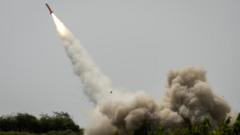Satellite images reveal Russia's plans to restart the Zaporizhzhia nuclear power plant, boosting concerns regarding its safety amidst ongoing conflict.
Russia's Renewed Efforts to Harness Ukrainian Nuclear Power Plant Raise Alarm

Russia's Renewed Efforts to Harness Ukrainian Nuclear Power Plant Raise Alarm
As Moscow builds power lines to connect a seized nuclear facility, international fears of a nuclear disaster intensify.
The ongoing conflict between Russia and Ukraine has taken a dangerous turn as new reports indicate that Russia is taking steps to exploit the nuclear capabilities of the Zaporizhzhia power plant, which it seized early in the war. According to a recent Greenpeace report, satellite imagery has unveiled that Moscow is constructing power lines in occupied southeastern Ukraine to connect the nuclear facility to its own electrical grid. This marks a significant development in understanding Russia's intentions regarding the plant, which has been offline amid international outcry.
The site of the Zaporizhzhia nuclear power plant has been a focal point of concern due to its close proximity to active battle zones, igniting fears of a potential nuclear catastrophe should operations resume under such precarious conditions. Greenpeace's findings, shared with The New York Times, highlight that since February, over 50 miles of new electricity lines and pylons have been established between Mariupol and Berdyansk along the Azov Sea coast. These findings were corroborated by The Times's own verification efforts.
Shaun Burnie, a nuclear expert with Greenpeace Ukraine, emphasized the significance of these developments, stating, "Putin’s plan for restarting the Zaporizhzhia nuclear plant depends on securing new electricity transmission lines — this is the first physical evidence of those plans." Despite the ongoing conflict, there remains uncertainty surrounding whether Russia aims to operate the plant during active hostilities or only in a postwar context. Analysts warn that the construction of additional transmission lines is essential for linking the facility fully to the Russian grid, which would require considerable time.
The situation underscores growing apprehensions about nuclear safety and the geopolitical implications of Russia's actions in Ukraine, as experts and international bodies continue to monitor these developments closely.
The site of the Zaporizhzhia nuclear power plant has been a focal point of concern due to its close proximity to active battle zones, igniting fears of a potential nuclear catastrophe should operations resume under such precarious conditions. Greenpeace's findings, shared with The New York Times, highlight that since February, over 50 miles of new electricity lines and pylons have been established between Mariupol and Berdyansk along the Azov Sea coast. These findings were corroborated by The Times's own verification efforts.
Shaun Burnie, a nuclear expert with Greenpeace Ukraine, emphasized the significance of these developments, stating, "Putin’s plan for restarting the Zaporizhzhia nuclear plant depends on securing new electricity transmission lines — this is the first physical evidence of those plans." Despite the ongoing conflict, there remains uncertainty surrounding whether Russia aims to operate the plant during active hostilities or only in a postwar context. Analysts warn that the construction of additional transmission lines is essential for linking the facility fully to the Russian grid, which would require considerable time.
The situation underscores growing apprehensions about nuclear safety and the geopolitical implications of Russia's actions in Ukraine, as experts and international bodies continue to monitor these developments closely.




















